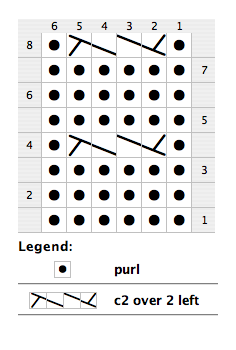Crossed Stitches

When working crossed stitches, one stitch or a group
of stitches are worked after the next stitch or group.
One thing to keep in mind is that crossed stitches make
a denser fabric because it increases the yarn tension.
This will effect your gauge. Good looming habits are a
must with crossed stitches. If you do not wrap
loosely, you will find it next to impossible to move
the stitches. There are some tricks to help you but
you should not rely on these alone.
There are two basic types of crossed stitches: the
cross stitch and the cable stitch.
| Crossed Stitches | ||
|---|---|---|
| Stitch | How Many Stitches Involved | Aids Used |
| Cross | Two Stitches | |
| Cable | Two Groups of Stitches | Cable Needle |
How crossing works, depends upon whether you are knitting circular or flat and for flat, which direction you are knitting. In needle knitting, the first stitch always stays back for a right cross and it stays front for a left cross. Use the charts below to determine which stitches stay in front and which stay in back when working on the loom. If you setup your stitches before knitting off the row, you can just memorize the sequence for circular knitting and always setup the rows from the right to the left. Because some people prefer to setup the rows in the same manner that you knit it, both information is provided.
Remember that you knit from right to left around the loom (clockwise).
| Crossed Stitches in Circular Knitting | ||
|---|---|---|
| Direction | Grouping | Position |
| Right | First | Front |
| Right | Second | Back |
| Left | First | Back |
| Left | Second | Front |
Remember that you knit from right to left for odd rows and then from left to right for even rows. Note: Setting it up, Front is on the bottom and Back is on the top.
| Crossed Stitches in Flat Knitting | |||
|---|---|---|---|
| Direction | Row | Grouping | Position |
| Right | Odd | First | Front |
| Right | Odd | Second | Back |
| Right | Even | First | Back |
| Right | Even | Second | Front |
| Left | Odd | First | Back |
| Left | Odd | Second | Front |
| Left | Even | First | Front |
| Left | Even | Second | Back |






